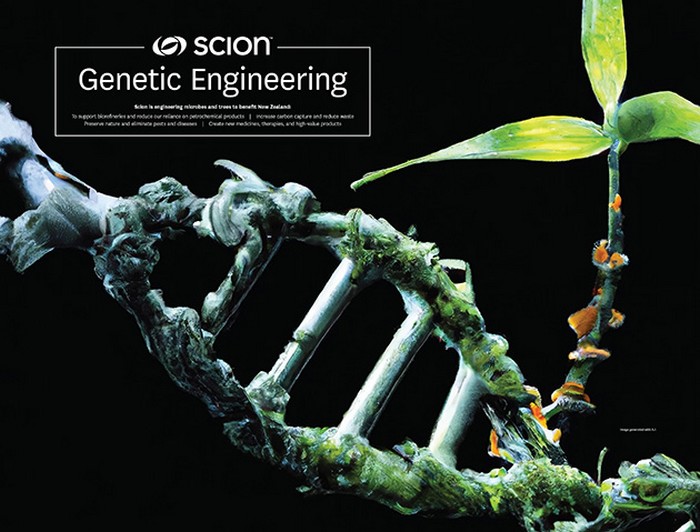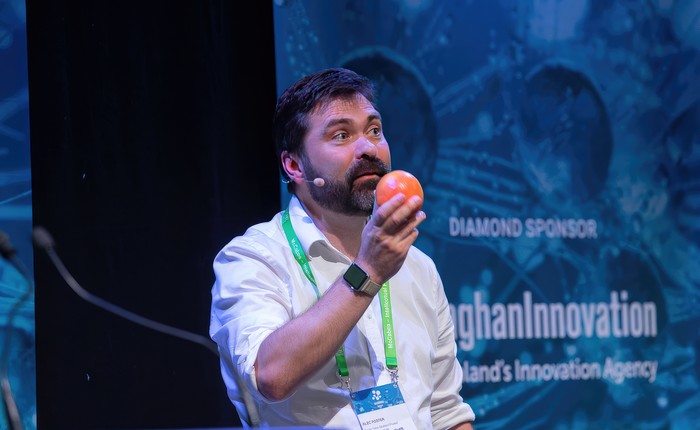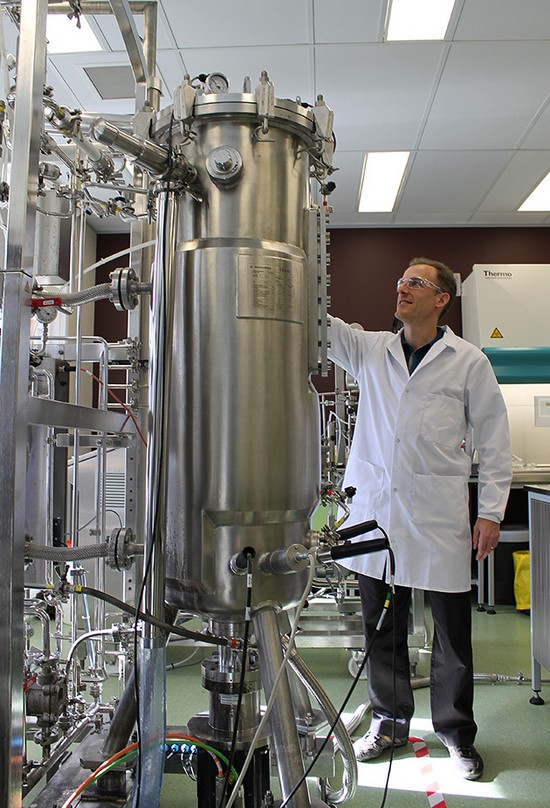Biotechnology solutions for a sustainable tomorrow

Biotechnology is creating a paradigm shift across all supply chains and its impact on our global economy could be bigger than the disruption of the Industrial Revolution. At an event in Wellington, Scion scientists shared how our R&D is leading this rapidly evolving area and where rules governing it are long overdue for change.
Recent global developments in genetic engineering (GE) are beginning to effectively address society’s most pressing challenges – climate change and sustainability. Scion is now taking a leading role in the GE space in New Zealand by leveraging its expertise in industrial fermentation and plant biotechnology to provide innovative solutions.
Scion’s capabilities and track record with GE were in the spotlight at the Life Sciences Summit in Wellington in March, hosted by Biotech NZ. Our researchers took centre stage at the two-day event, leading discussions in three distinct sessions: Genetic Engineering and its place in New Zealand, Creating sustainable products from biotech, and Synthetic biology for New Zealand’s future. These sessions highlighted the benefits, opportunities, and challenges of genetic engineering in the future for industry professionals and government officials.
Due to the impact of climate change, expanding and ageing populations, and an expectation that food and fibre sectors must increase production and operate more sustainably, industries are recognising the critical need to adapt and move on from the thinking and infrastructure of the past.
The Scion team, led by portfolio leader for Bioproducts and Packaging Dr Alec Foster, joined other leaders in the biotechnology and life science fields to highlight how genetic modification provides a way forward.
Colleagues, including microbial biotechnology team leader Dr Christophe Collet, molecular physiology team leader Dr Mathias Sorieul and plant biotechnology lead scientist Dr Glenn Thorlby emphasised how GE research can lead to new medicines and therapies, tackle challenges in food and fibre production, preserve nature while eliminating invasive species, provide alternatives to petrochemical products, and reduce CO2 emissions.
“Genetic engineering is one of the primary mechanisms to save the planet and improve our lives,” Foster says.


Leadership and a desire for change
During his presentation that pointed to perceptions of GE risk, Foster held a grapefruit and explained how today’s technology is far more precise than those used in the past to develop new foods. Organic red grapefruit, widely sold in supermarkets today, were developed in the 1960s and 1970s using radiation to create random mutations in grapefruit to produce new varieties. There was no way to predict what the mutations would be – it was luck whether the desired changes, in this case a sweeter flavour and red flesh, would occur.
With the advent of CRISPR technology, a targeted form of genetic engineering with the ability to make small changes at a pre-selected site in the genome, now we can choose a desired outcome. Scion are world leaders in utilising CRISPR in conifers and the first to sequence the Pinus radiata genome.

Scion is also leading New Zealand in fermentation technology, utilising bacteria and yeast to convert industrial waste streams and greenhouse gases into high-value products. Scientists are developing bioplastics from sustainable sources, reducing the need for petrochemical products. Genetic tools are also being developed to modify new types of bacteria – all under strict legislative framework that is now nearly 20 years old.
In New Zealand, laws governing new organisms, including genetically modified organisms (GMOs) fall under the 1996 Hazardous Substances and New Organisms Act (HSNO). It established a process for assessing and controlling the environmental risks of GMOs.
As time has marched on, New Zealand’s laws are now some of the most restrictive for the use of genetic technologies in the world. Scion is the only organisation conducting field trials with genetically modified (GM) plants in the country.
Although the tough regulatory environment has created barriers for research, New Zealand is able to import various products made with genetic engineering, including washing powder, insulin and almost all products made from cotton. GE is already a part of our daily lives, and more transparency about it is needed, Foster says.
Years of worldwide experience has shown genetic technology is as safe as conventional breeding. - FOA President Grant Dodson
Internationally, GE research has progressed rapidly. Regulations in the United States and United Kingdom were updated as the technology evolved, allowing research and products to be trialled and progress to the market. The European Union is expected to follow shortly.
With concern mounting that New Zealand isn’t keeping pace with global GE trends, Scion has joined other research institutes calling for debate on genetic technologies.
Earlier this year, Science New Zealand, an organisation representing the seven Crown Research Institutes (CRIs) and Callaghan Innovation, published a paper on GE technologies and the need for an informed debate about how the country is placed, pointing to how they have a legislative mandate to undertake research of benefit to New Zealand and to promote and facilitate technological developments.
CRIs are using genetic editing as a tool in their research to develop novel product concepts. Gene editing allows for simple and predictable changes compared with older technologies – as Foster referenced with the Rio Red grapefruit.
In its paper, Science New Zealand noted, “the Productivity Commission and the Climate Change Commission have both said that New Zealand is going to need to use modern genetic editing technologies to meet the challenges facing us”.
Foster says a collective sense of urgency for change has emerged, with more open and candid discussions about genetic technologies.
“The debate has evolved from preliminary stages and hypothetical possibilities to tangible products that offer real-world advantages for both consumers and the environment. There is an increasing realisation that if we don’t move with the rest of the world, there will be economic consequences.”

Modern genetic technologies in 2023 and beyond
While debate continues, it’s clear genetic technologies will impact modern society and New Zealand. Foster, together with Scion colleague Dr Glenn Thorby, contributed to a reference document produced by Te Puna Whakaaronui, NZ’s independent food and fibre think tank. The report WELL_NZ: Modern Genetic Technology describes the rapid advancements and changes in genetic technology, as well as the potential impact of these technologies for food and fibre in the coming decades.
Te Puna Whakaaronui was established to support the government’s Fit for a Better World roadmap to transform the food and fibre sectors.
Foster and Thorlby made several contributions that are referenced in the report. Scion data from an independent survey gauging public understanding and opinions on genetic technologies also features.
In response, and in keeping with the collective shift in thinking about GE, the Forest Owners Association (FOA) called for New Zealand to urgently update its legislation to bring management of the risks surrounding genetic technology, and the opportunities it provides, into the modern era.
The FOA is backing Scion’s development of a sterile Douglas fir – research that is currently restricted to the lab. If allowed to progress, it could lead to the development of trees which can’t seed, immediately ensuring that no wilding trees could spread.
FOA president Grant Dodson says the current legislation governing genetic technology is “outmoded, inconsistent and out of step with the rest of the world”.
There is an increasing realisation that if we don’t move with the rest of the world, there will be economic consequences. - Dr Alec Foster
“The HSNO is nearly two decades old, and in the meantime, how to guarantee the safety of genetic technology has become well known,” he says. “Researchers can now target gene rearrangements with technology such as CRISPR-Cas9.
“Years of worldwide experience has shown genetic technology is as safe as conventional breeding.”
Foster adds that an informed discussion on GE is key to the future of New Zealand and its bioeconomy.
“Without an informed public, genetic engineering will remain a polarised issue lacking nuance, and constructive dialogue, which is crucial to harnessing its potential for the betterment of society, the environment, and New Zealand’s global competitiveness.”

